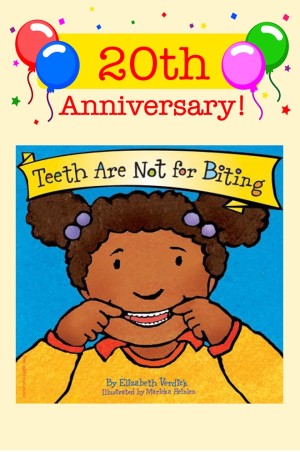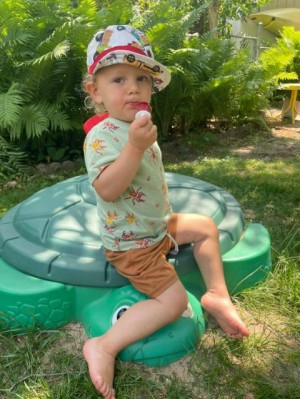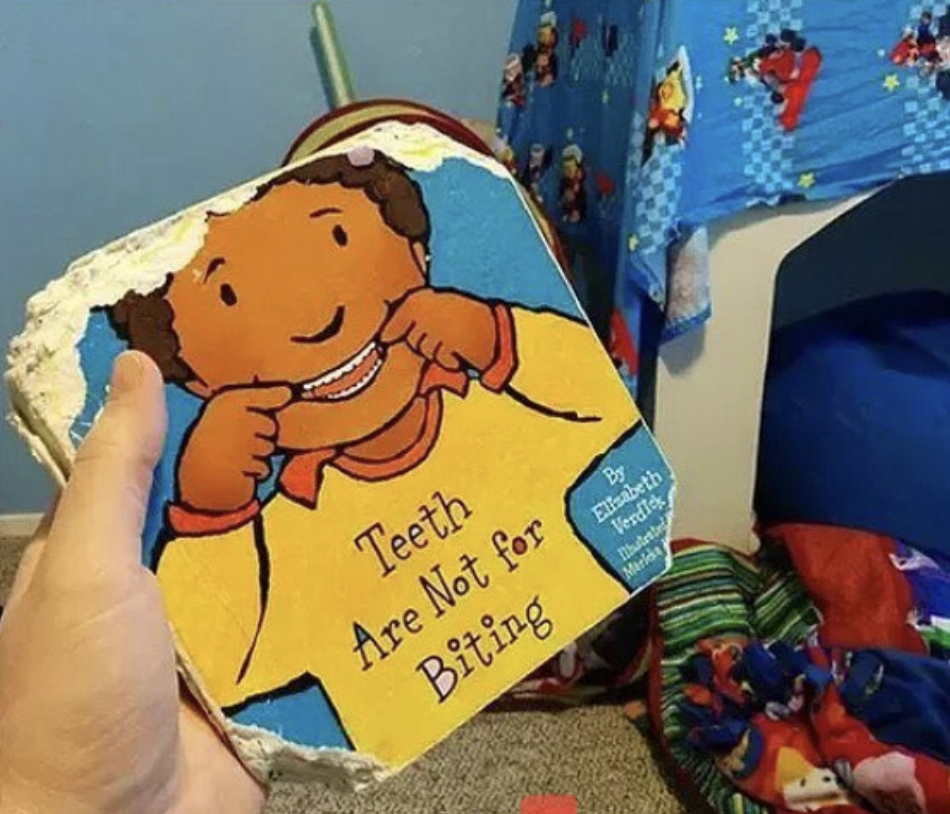 It’s hard to believe that our little book on not biting is celebrating 20 years in print! Back when the book came out, my son was two and my daughter was six. Yes, we had biting incidents to deal with! And Teeth Are Not for Biting was born.
It’s hard to believe that our little book on not biting is celebrating 20 years in print! Back when the book came out, my son was two and my daughter was six. Yes, we had biting incidents to deal with! And Teeth Are Not for Biting was born.
Now a new generation of toddlers is ready for their turn with the book. Katelyn Martens-Rodriguez is a children’s librarian and mother of this little cutie (see photo), Kyogen Joaquin, or KJ. Like many toddlers, KJ lives life full-throttle, rushing from one activity to the next, eager to explore. He doesn’t need teething to slow him down!
 Katelyn says, “Teething has been a long journey for KJ, who has been drooling on and off since he was 4 months old. He has been inconsolable a handful of nights due to tooth pain. It’s easy to tell when he’s teething—KJ’s cheeks redden, he rubs his gums, and he pokes at the back of his mouth.” Sometimes, when he’s tired and teething, he bites and Katelyn has to say, “Teeth are for food, not mamas.” KJ knows to ask for ice, teething toys, and popsicles. But the biting? It happens fast. Toddlers tend to bite as a result of pain, frustration, or just to get a reaction.
Katelyn says, “Teething has been a long journey for KJ, who has been drooling on and off since he was 4 months old. He has been inconsolable a handful of nights due to tooth pain. It’s easy to tell when he’s teething—KJ’s cheeks redden, he rubs his gums, and he pokes at the back of his mouth.” Sometimes, when he’s tired and teething, he bites and Katelyn has to say, “Teeth are for food, not mamas.” KJ knows to ask for ice, teething toys, and popsicles. But the biting? It happens fast. Toddlers tend to bite as a result of pain, frustration, or just to get a reaction.
I love knowing that parents and educators still reach for my book when biting episodes inevitably crop up. Child-development expert and early-childhood educator Sara Erickson has used Teeth Are Not for Biting with toddlers and their parents to help put words to children’s experiences when they’re learning not to bite.
Below, Sara shares her advice for handling those “Help—I have a teething toddler!” moments:
- Stay calm—young children are only beginning to learn how to handle their bodies and emotions. You may feel triggered as a parent if your child bites, but try not to get too angry or worried. Practice keeping your own emotions in check before you respond.
- Stay factual—narrate what happened without shaming the child. Saying “You put your teeth on his arm and that hurt him. He’s crying because it hurt,” tends to work better than yelling or scolding. You can also suggest words that might have helped with the problem that led to the bite. “You wanted her to move away. You can tell her, ‘I need space’ instead of biting.”
- Care for the person who was hurt—use gentle, factual language with the child who was hurt as well. If possible, allow the child who bit to see you comfort and care for the person who was hurt.
- Be a detective—what happened just before the bite? Was the child overtired, overwhelmed, frustrated, in a small space with others, or in pain from teething? Use those clues to help you watch for other moments when a bite might happen and calmly help meet your child’s needs before they become too much. Supporting a child before they bite and teaching them other ways to meet their needs is often the best way to get a child to stop biting.
- Use your words—an important message in Teeth Are Not for Biting is that simple, positive language can help us through struggles and upsets. The book encourages parents not to yell or use scolding phrases like “No biting!” or “Don’t bite!” A gentler approach keeps everyone calmer. As parents or caregivers, we often tell children to use their words instead of biting, but it’s helpful when adults use their words too. Children who have been exposed to more words1, especially about emotions2, regulate their emotions better, even if they do not use those words themselves.
- Know when to step in—it’s easier to offer support when emotions are rising than once they overflow. If conflict is brewing or your child is in a situation that tends to lead to biting, calmly move close to your child. You might use simple, factual language to narrate what is happening without judgement3
- You could say, “You wanted that block, but he is holding onto it. He is pulling it away and saying no.” Allow children the chance to work things out together, as long as everyone is safe. Children often solve problems more successfully when we slow down and put words to what is happening.
- Model self-regulation—your child is always watching what you do and say. If you’re struggling with the emotions that biting can provoke, talk with other trusted parents or caregivers. Most people who care for young children have experienced the biting issue, and they may be able to offer support. And remember, toddlers are just starting to learn how to handle their emotions and their bodies—and that’s a big adjustment! Give your child (and yourself) grace as you figure it out together.
One last thing…you’re not alone. Parents everywhere deal with the biting issue. One such parent posted this photo on Reddit, noting the fine sense of irony their child was developing. The photo made it all the way to The Ellen DeGeneres Show.

Footnotes
- Vallotton, C., & Ayoub, C. (2011). Use your words: The role of language in the development of toddlers’ self-regulation. Early Childhood Research Quarterly, 26(2), 169–181. https://doi.org/10.1016/j.ecresq.2010.09.002
- Senehi, N., Brophy-Herb, H. E., & Vallotton, C. D. (2018). Effects of maternal mentalization-related parenting on Toddlers’ self-regulation. Early Childhood Research Quarterly, 44, 1–14. https://doi.org/10.1016/j.ecresq.2018.02.001
- Lansbury, J. (2019, April 26). 5 benefits of sportscasting our child’s struggles. Elevating Child Care. https://www.janetlansbury.com/2013/04/5-benefits-of-sportscasting-your-childs-struggles/

